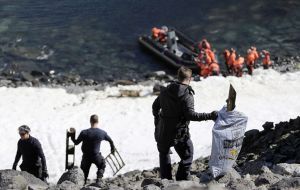MercoPress. South Atlantic News Agency
HMS Protector recovers equipment abandoned in remote Antarctic island
 A flurry of activity saw sailors and marines attack the site with spades, saws and ice picks, freeing numerous items, including rope, skis, scaffolding and barrels
A flurry of activity saw sailors and marines attack the site with spades, saws and ice picks, freeing numerous items, including rope, skis, scaffolding and barrels Personnel from HMS Protector have removed equipment abandoned more than 30 years ago on a remote island in Antarctica. The ice patrol ship attempted to remove equipment three years ago from Brabant Island – the second largest island of the Palmer Archipelago within the British Antarctic Territory – but were thwarted by bad weather.
A party of Royal Marines initially went ashore to the site, returning with a three-meter long black metal sledge, which had been used to transport a skidoo by a Joint Forces expedition in 1983-5.
The following day a number of personnel were taken ashore by the ship’s Zodiac vessels, landing within sight of chinstrap penguins and a solitary leopard seal sunning itself on the pebble beach.
The previous day the Royal Marines had moved sacks of equipment to the beach, but other abandoned kit was stuck firmly in ice. A flurry of activity saw sailors and marines attack the site with spades, saws and ice picks, freeing numerous items, including rope, skis, scaffolding, barrels and Sudocream.
Working in teams, the crews also found maps, socks, photos and cutlery. One find, a culinary spice rack, was handed to one of Protector’s chefs, with the message “it may improve your culinary skills.”
The task took several hours and after clearing the site, personnel covered the ‘dig’ with fresh snow. Several tons of kit were taken back to Protector from Brabant, which lies off the west coast of the Antarctic Peninsula Earlier on her patrol Protector visited the British Antarctic Survey at Signy Island in the region’s South Orkney islands.
The island, situated below 60 degrees latitude to the North East of the Antarctic Peninsula, is home to a plethora of wildlife, including penguins and many different breeds of seal that on whole number more than 20,000, the most prominent being the Elephant Seal.
The only humans that inhabit the island are five scientists from the British Antarctic Survey. However, due to the severity of the Austral winter on the island, the huts are only occupied during the Austral Summer from November to April.
The scientists undertake a number of projects whilst accommodated on the island, which benefit from the remote and un spoilt ecosystem that thrives on and around the landmass.
A contingent of Royal Marines went ashore to the base while Protector, which was greeted by a pod of whales, negotiated the neon blue and white icebergs.
The ship’s survey motorboat James Caird IV surveyed the waters around the island before a number of Protector’s crew prepared to go ashore for the night.
Once a whaling station, the personnel landed alongside a wooden jetty on Signy. A crumbling concrete jetty sits off to the side of the buildings, and a huge rusting cylinder, several meters in length, floats in the shallows in front of the encampment, once used for boiling whale blubber; it is a potent reminder of the region’s principal industry in a bygone era.
A huge whalebone adorns the entrance to the main hut that is complimented by an old rusted whale harpoon sitting beneath it. The harpoon is the size of a man and several inches in diameter with a detachable arrowhead. Countless more arrowheads line the top of each concrete pillar on which the main hut is built.
The sailors set up camp and went to watch the wildlife, mainly Elephant Seals, before preparing to welcome in 2017 with a dinner of sweet and sour chicken, chicken tikka and chilli con carne, washed down with coffee and hot chocolate.
Before leaving Signy, a number of the ship’s company wrote postcards, which will not leave the island until March.
Protector left Devonport in October 2015 and completed an historic patrol to the East Antarctic and Ross Sea. She is due to return to the UK this summer (austral winter).




Top Comments
Disclaimer & comment rulesCommenting for this story is now closed.
If you have a Facebook account, become a fan and comment on our Facebook Page!